Guggenheim in Bilbao - "not dry and dull"
last update: 20 Nov. 2019
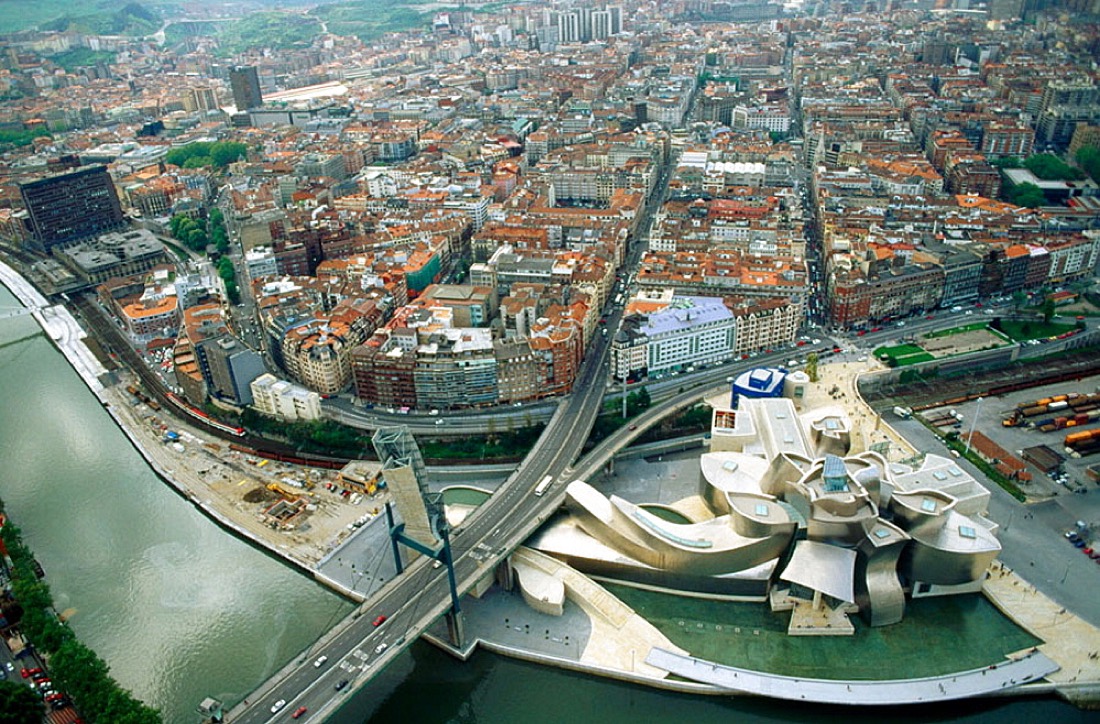
Bilbao is the largest city in the Basque Country (or more specifically the Hegoalde, or Southern Basque Country, i.e. the part entirely in Spain), however the local parliament and headquarters of the Basque Government is in Vitoria-Gasteiz.
This page is dedicated to our visit to the Guggenheim Museum, which in 2017 was celebrating its 20th anniversary. Our trip just involved a one-day visit to the ‘Miracle of Bilbao’ and an excellent evening meal in the museum bistro. Our ‘pilgrimage’ is just what the Basque region wanted, so I suppose they got it right.
I make no excuses for focusing more on the museum building that its content. In fact, my wife and I were a bit underwhelmed by what was on show inside the museum. The starting-point for this page is the Wikipedia article, but I have tried to add the occasional more in-depth, or opinionated perspective. Wikipedia tells us that in 1991 the Basque government offered to fund a Guggenheim museum to be built in the derelict port area on the Nervión River (the port was once the city’s main source of income). What it does not say is that the original idea of the local government was to find a new place for an important collection of medieval through to 19th century paintings held in the Museo de Bellas Artes. Nor does Wikipedia tell us that in 1991 Guggenheim’s director, Thomas Krens, was also looking for ways to expand Guggenheim New York and stabilise its finances (and that he had already looked at both Massachusetts and Salzburg as options). In fact he has been quoted as saying, “This is not a cultural project, it’s an economic development project”.
Just an added word of praise for Carmen Gonzalez the curator for Spanish Art at the Guggenheim. I have read that she was responsible for the first contacts between the Guggenheim and Bilbao.
The Context
We must remember that during the 80’s, the city’s industries such as iron, steel, and shipbuilding were in decline. At its worst, unemployment hit 25% and the Basque paramilitary group ETA murdered and planting car bombs in the city. On top of that the river environment was polluted, and the city was blighted by gridlocked traffic and crumbling warehouses.
We should also not forget that Bilbao had lost out in the Spanish regeneration wave, when Barcelona hosted the Olympics (1992), Seville the World Exposition (1992), and Madrid became the European Capital of Culture (1992).
The deal was that the Basque government would cover the $100 million construction cost. They would also create a $50 million acquisitions fund, pay a one-time $20 million fee to the Guggenheim and subsidise the museum’s $12 million annual budget. In exchange, the Guggenheim Foundation agreed to manage the institution, rotate parts of its permanent collection through the Bilbao museum and organise temporary exhibitions.
The museum was built by Ferrovial at a cost of $89 million. However it has also been reported that the start-up costs for the Bilbao project were almost $230 million. The breakdown of the fees was $12.1 million for the architect Frank Gehry, $6.4 million for executive architect IDOM, $100.8 million for construction, $24.7 million to the Guggenheim Foundation to run the museum, $9.9 million for the land, $44.5 million to start the collection, and $30.3 million for other operating costs.
This might sound like a lot on money, and even more so because it was only one part of a larger regeneration project for the old Abandoibarra industrial area (initiated in around 1989). This involved a new tram, training schemes, metro lines, the Iberdrola Tower, and a cultural centre with other designer/architects such as Philippe Starck and Foster + Partners. We should not forget the cheep flights to a new airport terminal. It has been said that the cost of the museum project was less than 1 kilometre of a new motorway. This is manifestly untrue. Figures I’ve found put 1 kilometre of motorway at between €4.6 million and €29.3 million, but the cost could be as much as €75 million in built-up and severely restricted areas (very dependent upon the country, region and terrain, as well as number of exits, bridges, etc.). So clearly the Bilbao site cost more than a couple of kilometres of motorway. However, the museum with its ’starchitecture’ has attracted 20 million visitors (more than 60% from overseas) and created more than 5,000 local jobs. It has been estimated to have so far generated €650 million of additional revenue for the Basque treasury. Our explicit decision to visit Bilbao to see the Guggenheim is the best example you can have of the ‘Bilbao effect'.
Finally, no matter how you look at it, the key message of the architect is that the museum was actually built for $300 per square foot, which is fantastic even for 1997 prices.
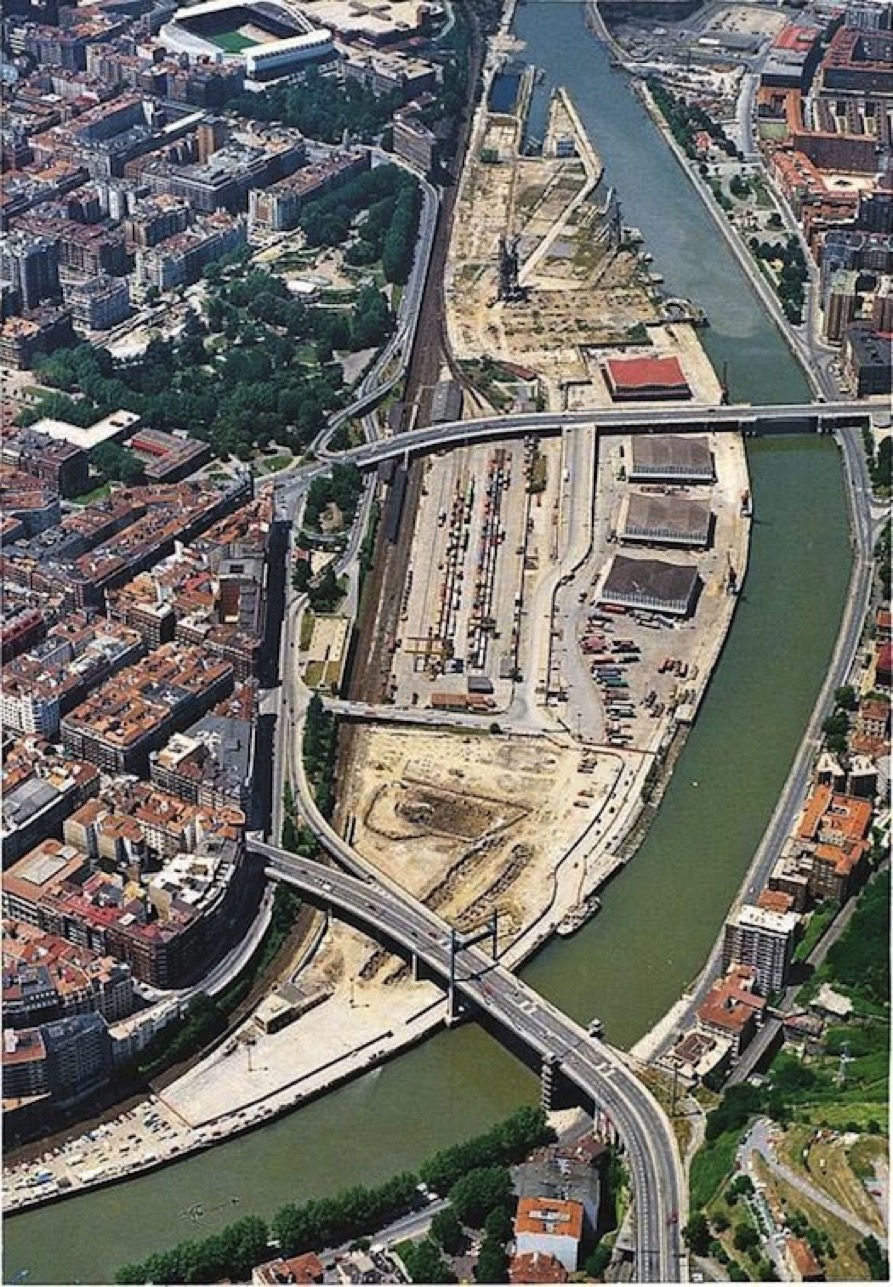

Some saw (and still see) the Guggenheim Bilbao as a miracle, opening new options in both architecture and museology. Others felt (and still feel) that the museum had abandoned it intellectual mission and had become just another corporation. I think both positions would accept that museums have increasingly become aware that they are world-renowned brands, so I guess that extending (can we say ‘franchising’) the brand internationally is an obvious step given that a good part of the collections sit in storage anyway (95% of the Guggenheim collection was in storage).
With Bilbao the packaging of architecture and a museum collection as a cultural, touristic and photographic experience, became the model to be copied. Experts talk about ‘civic catalysts’, and bringing drama into a cities daily life, a bit like industrial expositions and world fairs did in the 19th C. Some new cultural buildings have been successful (but not as successful as Bilbao), others have become just another tourist attraction, and other still have become mired in difficulties and debt. Guggenheim itself never got SoHo, Berlin and Las Vegas set up as permanent Bilbao-like or New York-like venues, although Guggenheim Venice has existed since 1951 and, above all, the future Guggenheim Abu Dhabi has been sold as Bilbao on steroids (but the completion date is still unknown). Perhaps the worst case is the $300 million that became $1 billion with Valencia’s City of Arts and Sciences (which by the way is well worth the visit).
One author rightly noted that in 1997 it was an imaginative and risky use of public funds, but the question is could the same investment be made today. Perhaps not, and that indeed is a shame.
Here is a video that describes the building of the museum, and goes into considerable detail about the actual design and construction details. It is a far better introduction than anything I could write. And this video is worth a look, if you understand Spanish. And finally this video interview with the architect Frank Gehry is certainly worth listening to (even if it is not focussed on Bilbao).
The building
In May 1991, once the memorandum had been signed between the Guggenheim and the Gobierno Vasco, the Pritzker prize-winning architect Frank Gehry was retained for site selection. By the end of 1991 a full agreement had been signed, one which included also the creation of a new Spanish and Basque art collection. The agreement was almost identical to a franchise, the Guggenheim would operate and manage the museum, and provide access to its collection (three exhibitions per year), but it would have no legal or financial obligations (just providing services). There was also an exclusivity clause that stopped Guggenheim expanding into Europe without the consent of the Gobierno Vasco. And finally Guggenheim Bilbao would retain the rights to their ticket sales and for retailing Guggenheim products throughout Spain.
The initial site suggested was a wine storage warehouse in Bilbao’s historic centre, but this was rejected by the Guggenheim. Tradition has it that Krens saw the perfect site whilst jogging. Gehry agreed, and Bilbao were really happy because they already owned the land.
In Spring 1992 three architects were given $10,000 each and 3-weeks to submit a concept. Two of them provided sketches of what might be called ‘classical’ options, whilst Gehry also provided scale models. Gehry was selected because of his more unusual design, and thus potentially stronger iconic identity. There were doubts. Could it be built? Could Gehry build it? The model we see below is the new model created after the first on-site visit.
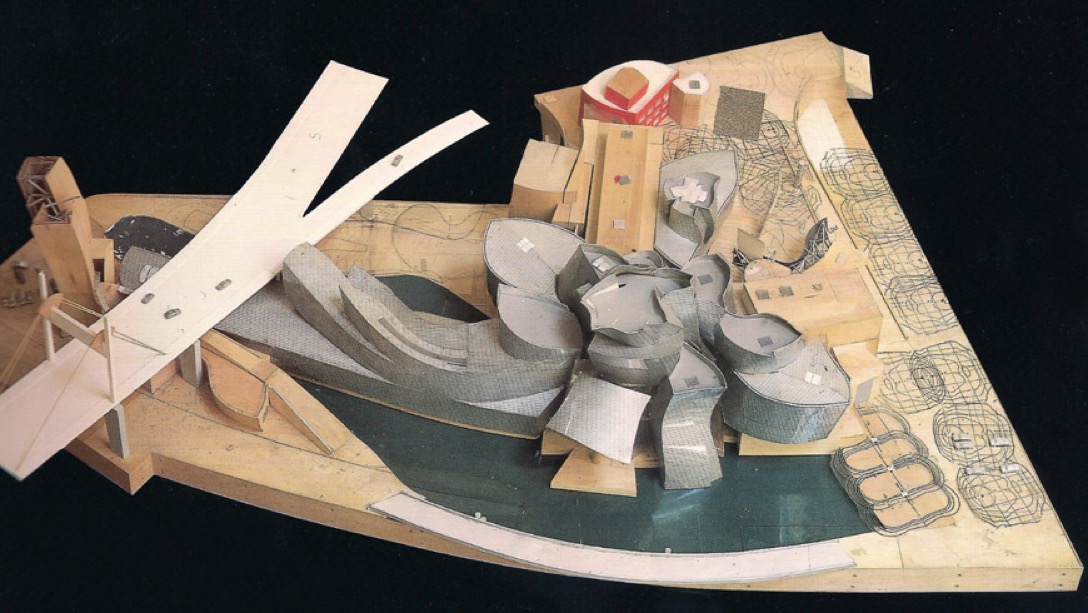
The Consorcio Guggenheim Bilbao was the ‘owner’ and ‘client’ (planning and construction) of the museum. Guggenheim was the program consultant, and Gehry the architect. IDOM was selected to be responsible for the budget, schedule, quality of construction and the adjustment to local technology (and they also took all legal responsibilities for the construction). To keep the building within budget the team agreed to reduce the original building footprint by 20%, and to have the cost of permits, etc. waived by the City of Bilbao.
The delivery date was fixed for end-1997, but the team wanted to move fast on the initial building in order to avoid that the museum construction became an issue for the 1994 Basque government elections. The problem was that in late 1992 only about 30 drawings existed of the future museum. IDOM estimated that about 1,000 detailed drawing would be needed and that building could only start in early 1995. So they adopted an overlapping design and construction model based upon dividing the building into construction packets, and coupled that with a realtime cost control system (new cost estimates was established every 6 weeks). This approach meant that they could hope to have the basic structure in place in 1994, put the façades on in 1995, and complete the interiors in 1996. Working back from those requirements, they fixed a calendar based upon design ‘freezes’, dates beyond which no modification were possible.
The complex shape of the walls and roofs required an innovative approach to the actual construction. They actually issued a public qualification competition to both educate contacts and establish how the winning contractors would be selected. Those selected actually participated in the final design of walls and roofs. Ferrovial has been mentioned, but in fact they were ‘only’ responsible for the structure, interiors and urban infrastructure. Other contractors handled the demolition of the old site, the building of the foundations, exteriors, and fittings. For example, a subcontractor joint venture Umaran/Permasteelisa was responsible for the curtain wall and titanium cladding (through a main contractor Balzola).
Only five contractors were invited to tender for the ‘exteriors’ and only three submitted bid, all over budget. Through a second round of bids, two managed to get within the target budget.
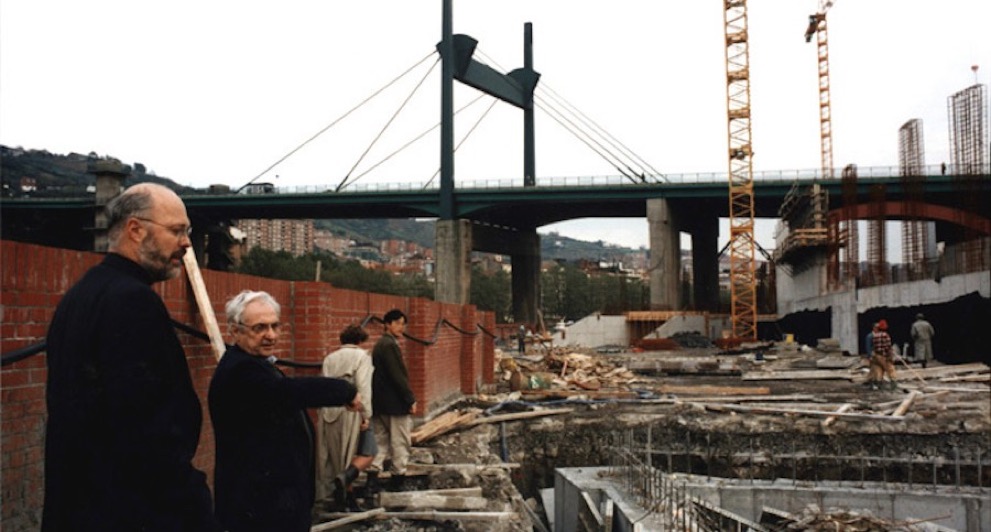
One interesting feature of the foundation design was necessitated by the proximity of the Nervión River to the museum site. Floods were a real possibility, so ‘water anchors’ of different sizes were built to counteract buoyancy in the event of a flood. These cable anchors were created by driving piles into the bedrock, then boring out their centers. A cable was then fed through the hole and anchored into the bedrock, after which the bores were filled with concrete. As a last step, the cables were tightened from the top. By the end of October 1993, 664 concrete piles had been built in-situ 14 meters below the surface.
A total of 18,000 cubic metres of low-permeability, reinforced concrete was used for the structural walls of the basement and mechanical areas.
As an additional precaution, all art displayed at the museum is mounted about the 500 year flood level.
The Gehry design was entirely based upon so-called CATIA (Computer Aided Three Dimensional Interactive Application), developed in 80’s (the one they used was from Dassault Systèmes and was developed for the aerospace sector). This allowed Gehry to manipulate three-dimensional solid models, and at the same time calculate the mathematics and produce the basic engineering specifications. The architect made a wood-plastic model, which was then 3-D scanned. The results went into the CATIA system, which then produced milled out forms of the different parts. If accepted, the files were sent to IDOM to be scaled up for construction tendering.
Gehry divided the museum into a number of complex polygon building blocks. He called them ‘integrated forms’, and gave each a name (River, Neo, T1000, Potemkin, Cobra, Fox, Flower, Tower S17, Fish, Boot and Canopy).
What you actually see (or don’t see) are three layers of steel. The first is just structural square sections, and there is a separate outer structure that provides the surface complexity. Between the two, is a 3 meter gap with steel connections that allow the outer structure to be finely adjusted. The outer skin consists of a steel cladding, thermal insulation, a Bituthene membrane, and finally the titanium tiles.
Originally the specification was for a hand-polished stainless steel cladding, although zinc and leaded copper were also considered. At the time Gehry had received a promotional sample of a titanium clad, and tests showed that it could also be an alternative, so it was included as an option in the bidding specifications. Just at that moment the world’s largest titanium manufacturer in Russia, put a huge amount into the market. This caused a massive drop in prices, making titanium less expensive than polished steel. The material was laminated in the US, cut in Spain, and each panel individually hand-bent on site. Titanium being much lighter than steel, it was far easier to mount on the structure. Because of the odd shapes and difficult access, the titanium panels were actually placed by specially trained climbers, and not installation technicians.
The stone used also has a ‘history’. The one chosen actually was from Israel, so supply was not reliable. But there was also a bankrupt quarry near Granada, which was re-opened for the Bilbao Guggenheim. Since then the quarry has remained open and is thriving.
Even the glass used has a ‘history’. There are 2,200 glass panels, 2,000 of which had unique curved shapes. But these curved panels are actually made up of arrays of triangular panes to give the impression of continuously curving surfaces (thus keeping the price down).
The final result is a building clad with 25,221 square metres of titanium, 34,343 square metres of stone and 6,136 square metres of glass.
At its simplest, it is two rectilinear arms, placed perpendicular to each other, and fused in a central atrium with a subterranean entrance. The ground floor has the most unusual spaces, with a cavernous ‘boat gallery’, whilst the rooms on the upper floors are more conventionally rectangular.

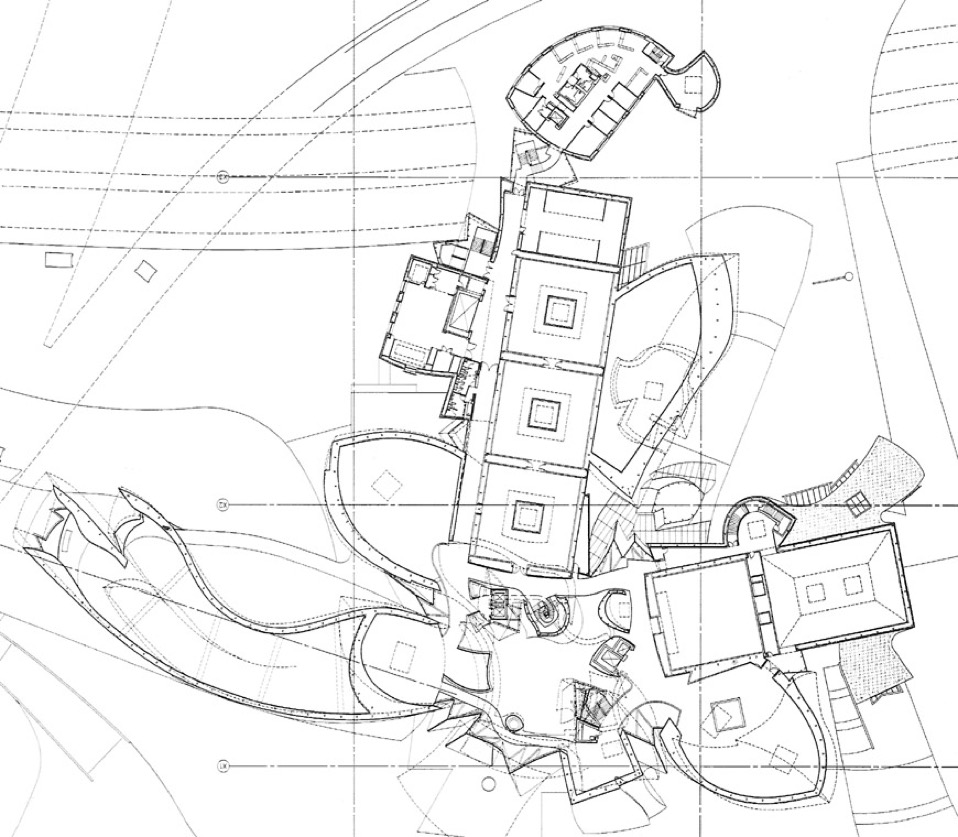
The atrium is the key space in the museum. Originally conceived as a central box-shaped exhibition space, Gehry was ‘forced’ by Krens to treat it as a piece of sculpture. There are connotations of Gothic cathedrals mixed with certain Art Nouveau and Modernist elements. At times it looks like some kind of modern style glass vase. Clearly the whole museum, and its atrium, have a high-tech look, but at the same time the entire structure was hand-built much like the medieval handcrafting of early cathedrals.
The discussion of the architectural influences on Gehry, and his influence on modern architecture, is on-going, and sometime quite ‘academic’ to say the least. Check out this dissertation if you are interested in knowing more.
A constant throughout all the descriptions and discussions about the architecture is the way the titanium skin constantly changes colour depending upon the weather and time of day. Below we have a couple of the more spectacular examples, but there are a multitude on the Web.

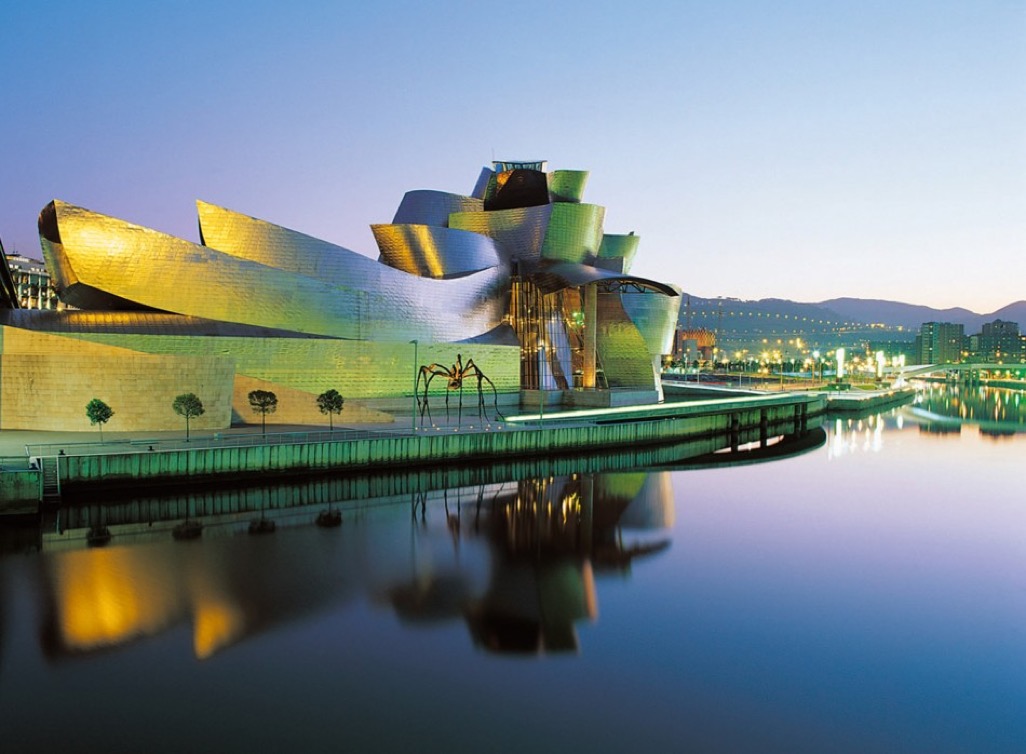
The Collections on Show
It is time to turn to what was on show. In principle it should be impossible to include photographs, since all the museum attendants appear to be exclusively dedicated to stopping visitors taking photographs. The reality is somewhat different. There are 1,000’s of images on the Web, but it must be said most are of past exhibitions.
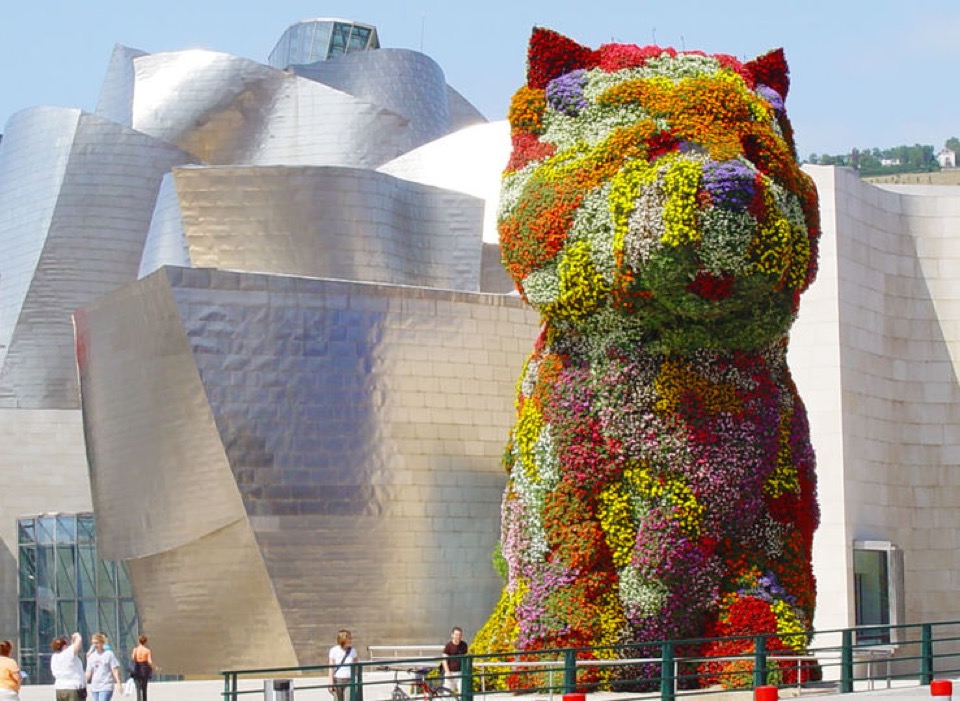
Approaching the museum the first thing you see is the 1992 Puppy ‘sculpture’ by Jeff Koons. It is said that this work echos the 18th century formal garden within a mix of two mass-cultural ‘feel-good’ icons - dogs and flowers.

You then go down to an almost underground main entrance. Some experts have pointed out that this entrance is in exact opposition to the ‘usual’ entrance to a museum, i.e. steps leading up to a very imposing Neoclassical temple. The entrance hall itself is very discrete. You buy your ticket, leave your coat and umbrella, and proceed to the central atrium. Probably you are looking down at the museum guide and the layout of the rooms, wondering where to start.
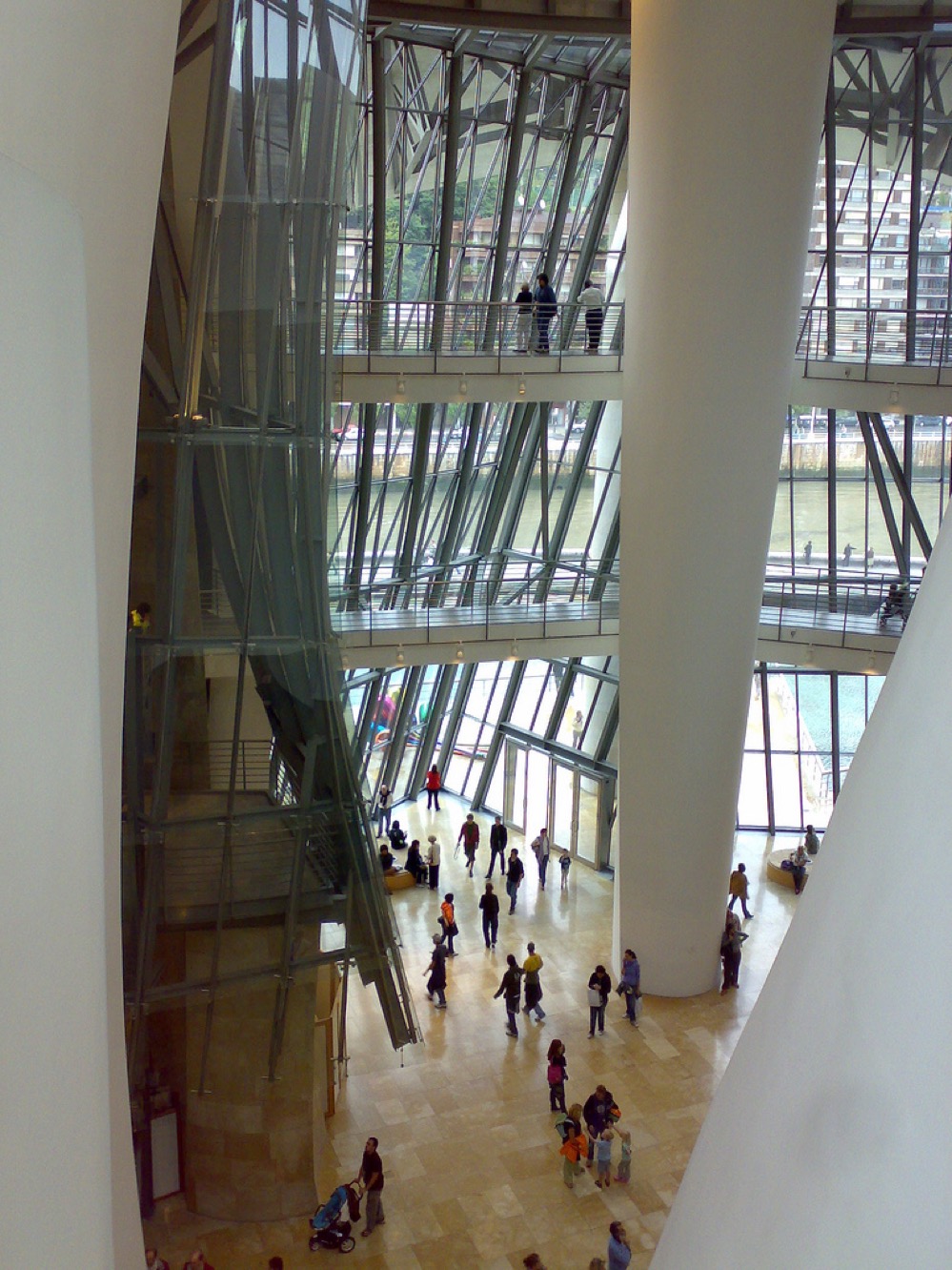

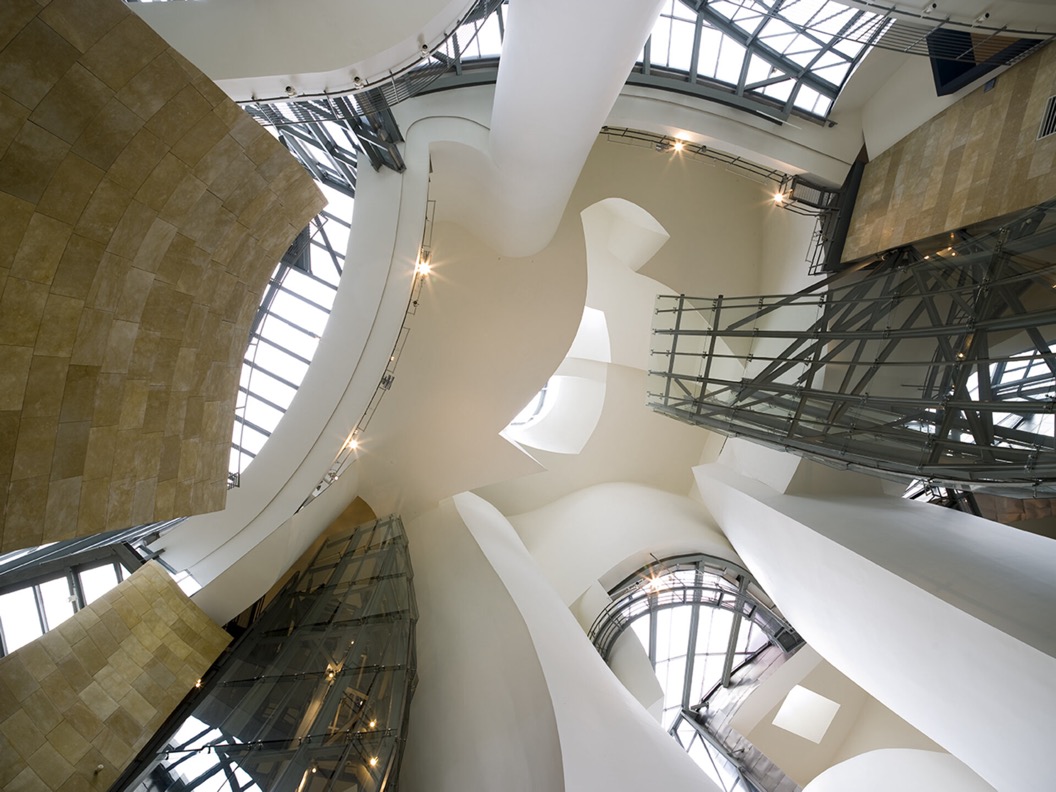

Walking through the atrium onto the terrace we find another ‘sculpture' by Jeff Koons, this time Tulips dated 1995-2004. Experts tell us he is challenging the limits between popular and elite culture, and is looking at emblems of childhood, i.e. banal inflatable objects. At least his work is colourful and a bit of fun, if nothing else.
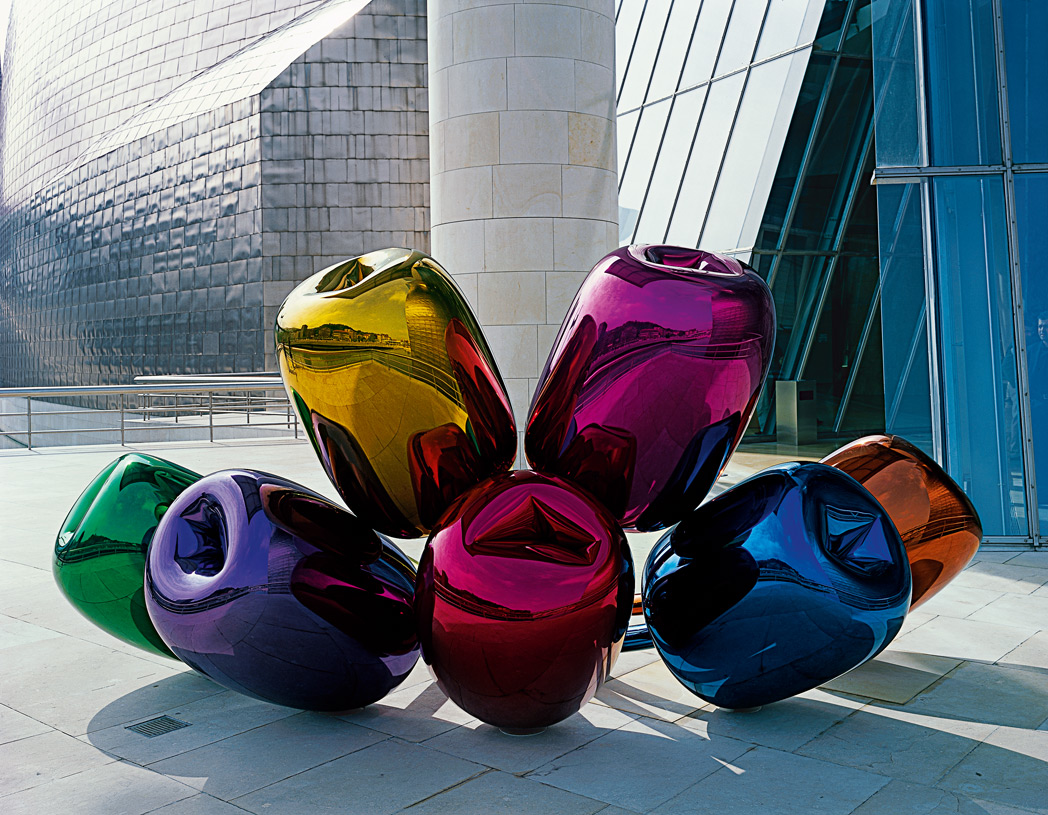
One of the first works we see is from the permanent collection. It is the massive ‘The Matter of Time’ by the Minimalist sculptor Richard Serra (2005). It is possibly that this is a collection of different pieces, and I think the central piece is called the Snake. Experts tell us that this sculpture does almost everything. The artist uses unconventional, industrial materials and accentuates their physical properties. He creates a ’new relationship’ with the viewer, because it is not placed on a pedestal or base. The work is supposed to ‘capture a rare sense of motion and instability’, and ‘create a dizzying, unforgettable sensation of space in motion’.
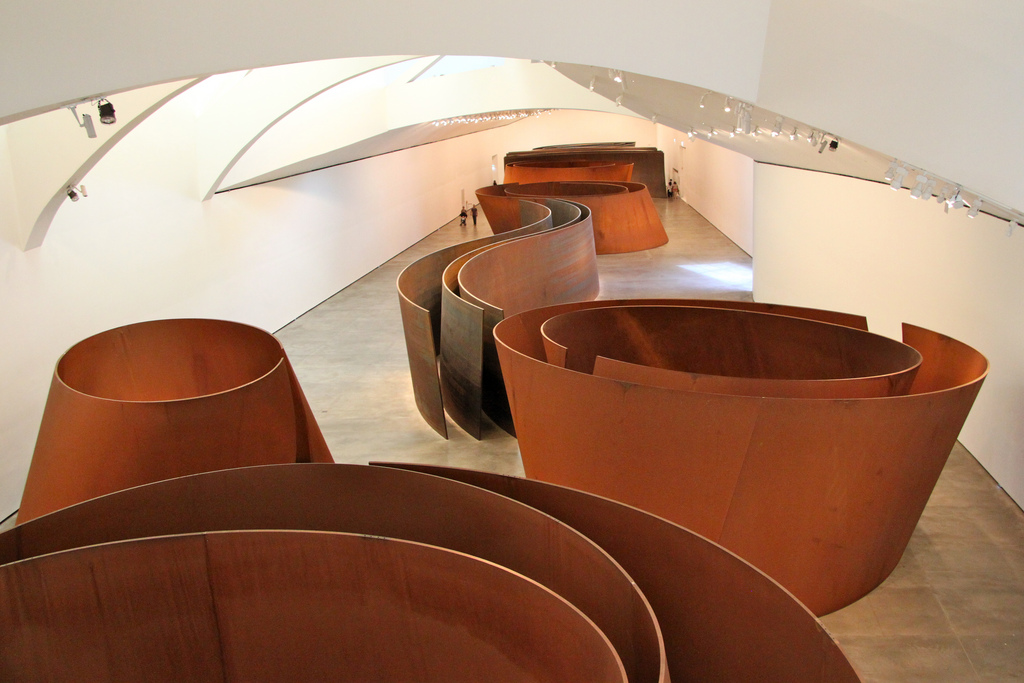
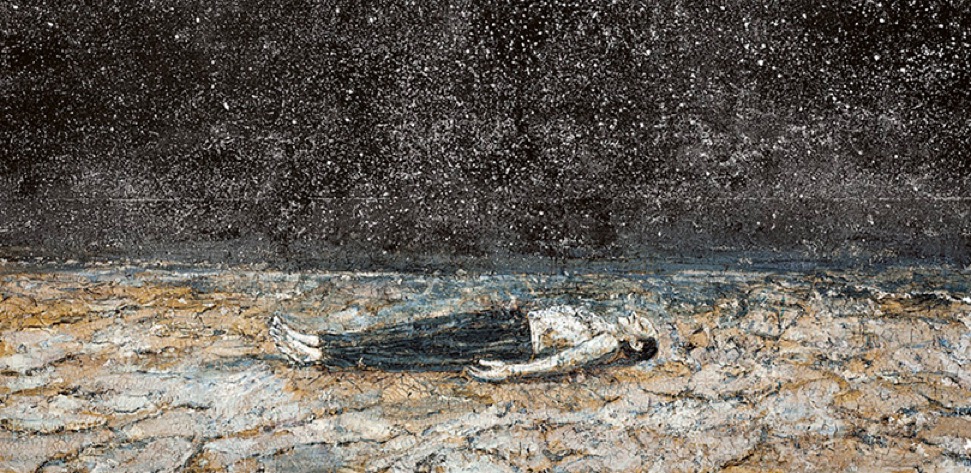
This is ‘The Renowned Orders of the Night’ by Anselm Kiefer, 1997. This work is supposed to confront aesthetic taboos, such as the rise of Fascism, and the universal themes of civilisation, culture and spirituality.

This silkscreen work by Robert Rauschenberg is in fact nearly 10 meters long by 2 meters high. It is called Barge because it is barge-like in its scale and dimensions. It is just a collection of transportation related themes and a lot of other bits such as caged birds and images of Old Masters. Even the experts have not been able to put a socio-intellectual twist on his work.
Below we have what everyone can see is an Andy Warhol. It is imaginatively called ‘One Hundred and Fifty Multicoloured Marilyn's’, and dates from 1979. This is Warhol ‘at his best’ with his "I think somebody should be able to do all of my paintings for me". Our experts have noted that the paint was thickly applied which they suggest is because Warhol was reflecting on his own mortality!

Enough?
The only highlight in the contents of the museum was an exhibition of 82 portraits by David Hockney. I might add that my wife thought they were unimpressive.
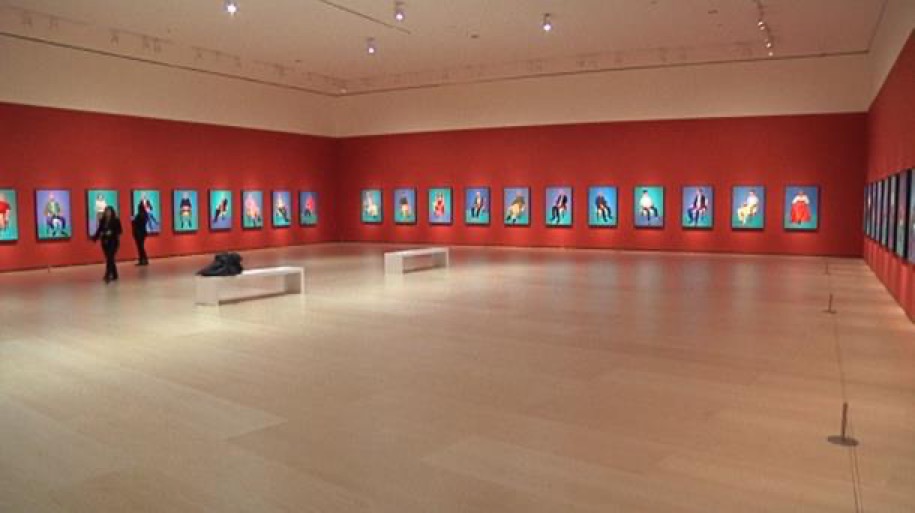
I liked them because they were colourful and you could see in most of the portraits a real person with a character captured on canvas.

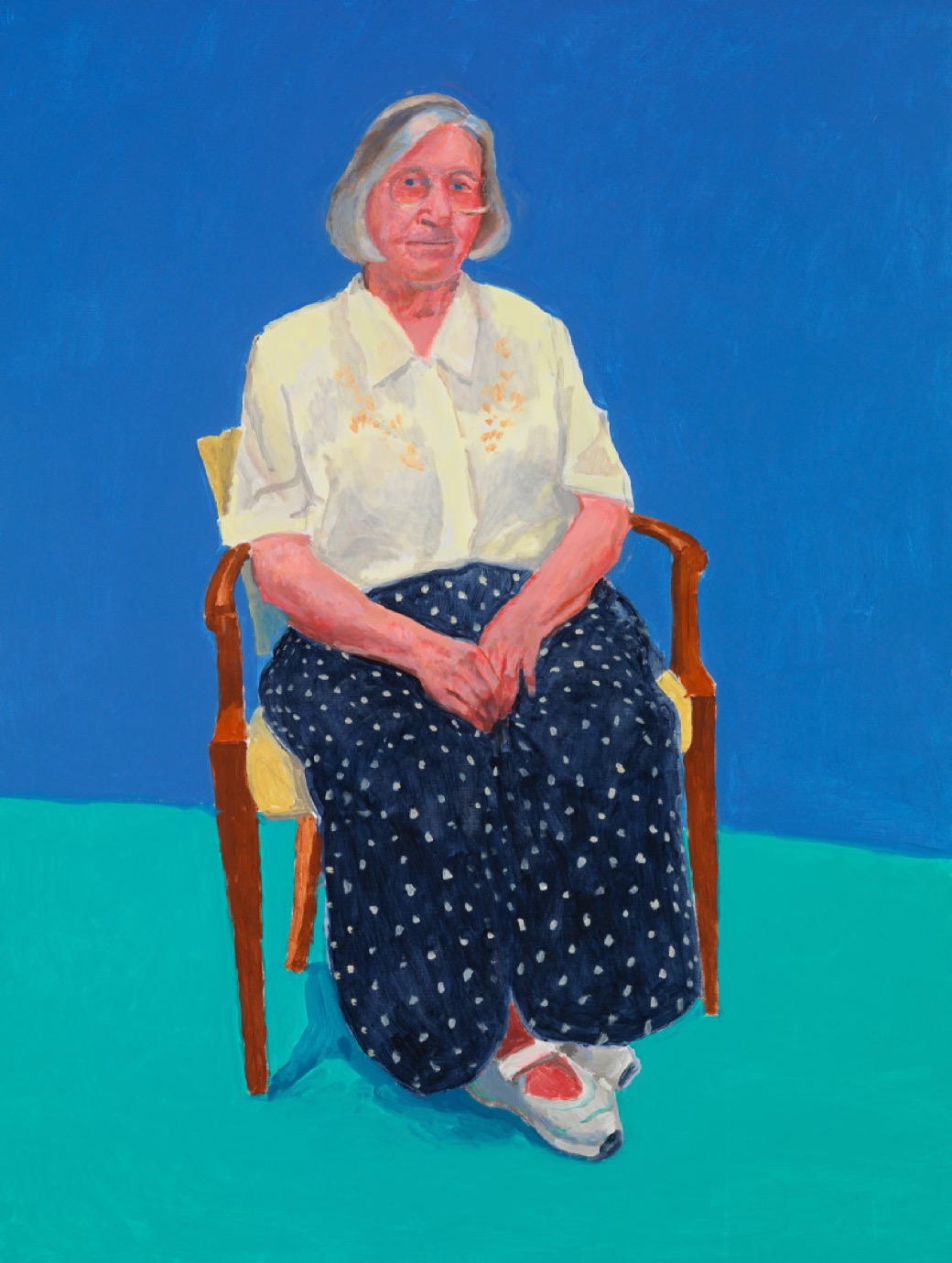
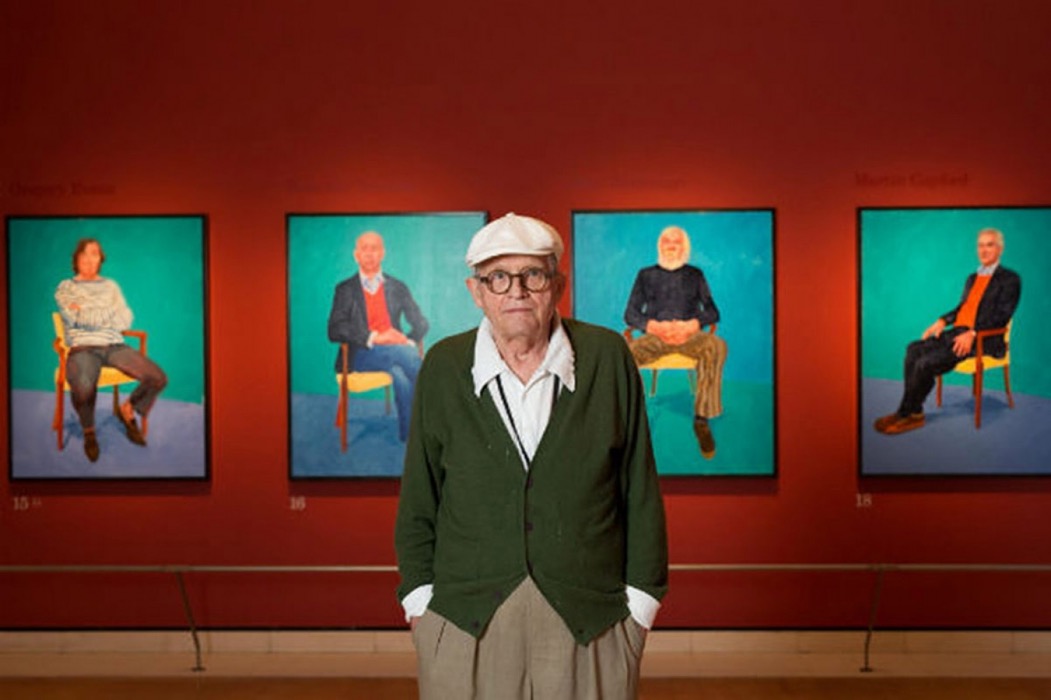
Frankly I can't imagine why anyone might be interested in artists such as Serra or Kiefer, but Koons is fun even if highly over-rated. Lucky Hockney was there, and if you are interesting in knowing more about him check him out here.
Conclusion
Was the detour to see the museum and its collection worth it? The building is worth the detour, but not the collection.
Would we go back to Bilbao? Yes, we felt that there was more to see and experience in the city. Again the museum did its job.
As a last comment, it is often the case that a 'side-issue' offers a unique insight into the life of an artist, a building's usefulness, or a historic moment in time. Concerning our building, it's the simple problem of keeping it clean. You have more than 23,000 square metres of titanium panels, more than 34,000 square metres of stone, and more than 6,000 square metres of glass. And almost all the vertical surfaces are curved. You try cleaning this…

The cleaning team includes 20 cleaners, 4 window cleaners and 4 "rope access technicians" (climbers). I didn't know that there is a IRATA (International Rope Access Trade) certification, with more than 74,000 rope access technicians worldwide.
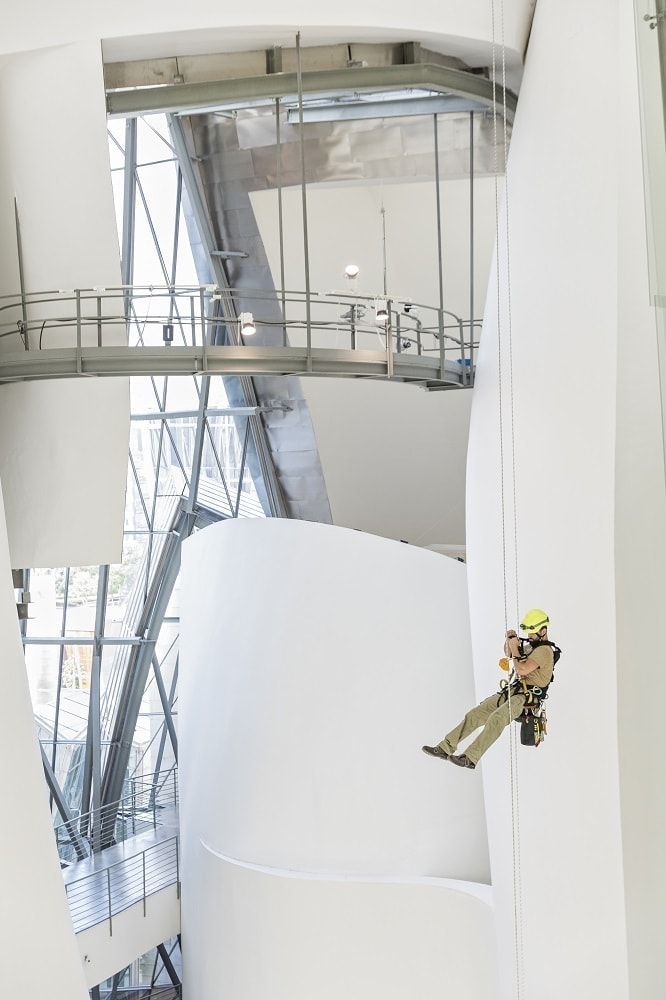
In addition, the full time maintenance team includes electricians and lighting specialists for structural lighting and electrical installations, refrigeration engineers for operating and maintaining the integrated temperature control system, painters for the daily painting of the gallery walls, metalworkers for the metallic structures, a joiner for maintaining the furniture and the more than 300 doors that the building is fitted with, a builder for changing limestone tiles and repairing walls in case of damage, and a fire prevention technician to maintain and supervise the complex fire extinguishing system in the building, and so on.
We close with a famous story about visitors admiring a cleaning cart, believing it was a work of art. The reality was that the original article came from La Voz del Becario, a parody new site. Unfortunately it was picked up and republished as 'serious' news, before being rapidly removed. Too late, the story had been immediately pickup by others, referencing the serious new sources. And so a piece of parody now lives on as a serious piece of information.